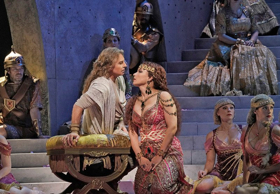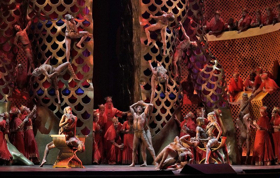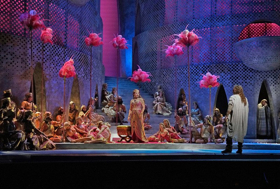Review: Met Opera Season Opens with New SAMSON ET DALILA, in Crazy, Rich Philistine Style

Photo: Ken Howard/Met Opera
Well, no one could accuse the opening of the Met's new season, with Darko Trasnjak's production of Saint-Saens' SAMSON ET DALILA, to Ferdinand Lemaire's libretto, of being drab. Starry, certainly. Over the top, definitely. Filled with feathers--absolutely. Call it "Crazy, Rich Philistines."
The pairing of Roberto Alagna (Samson) and Elina Garanca (Dalila) in Bizet's CARMEN reportedly sent ripples of thrills through Met audiences. So reuniting them in another French opera where sex appeal plays a major role must have seemed a no-brainer. If so, things didn't quite work out as planned, particularly since the two aren't on stage together (or not in a clinch) for much of the opera and have smaller voices than are usually most effective. (A different, less glamorous cast brings
that in the spring.)
Another problem appeared to be some vocal distress on Alagna's part; whether he was under the weather (unannounced) or needed an inordinate amount of warm-up time, he definitely didn't seem his best in Act I. Things were better in Act II, though his highest notes were an issue for most of the evening and he ended on a croak.

Ken Howard/Met Opera
There was no such problem with Garanca, who was a wonderful Octavian in DER ROSENKAVALIER opposite Renee Fleming and as Sara, the title character's squeeze in ROBERTO DEVEREUX with Sondra Radvanovsky at the Met. At her best, her mezzo sounded lush and rich and she was evil personified opposite Alagna's Samson, even if she didn't quite bring the volume that would have been more effective. And a big part of Act II is spent with bass-baritone Laurent Nouri, plotting Samson's downfall. Though Nouri did some fine singing, too, the lack of chemistry during their long scene was palpable and they could have used more directorial intervention to speed things along.
The Met orchestra sounded in fine form under Sir Mark Elder's baton, up for all the challenges in Saint-Saens varied score and working well with the singers.

Photo: Ken Howard/Met Opera
Director Trasnjak is making his Met debut with this production and I think he may have been overwhelmed by the size of it, choosing to concentrate on getting the Met's massive forces of chorus, dancers and supernumeraries in formation and neglecting some of the individual performances, like the one just described. (Indeed, Trasnjak was at his best in the large ensemble scenes, eg, Act I's almost oratorio-like music, which handsomely showed off the well-known strengths of the Met chorus, and the orgy and finale of Act III.)

Photo: Ken Howard/Met Opera
While the opera has been chosen for opening night four times (its first Met performance had been in 1895, starring Francesco Tamagno, Verdi's original Otello, as Samson) and has some gorgeous music, including Dalila's big aria, "Mon coeur s'ouvre a ta voix (My heart opens at your voice)," the promise of Act III's bacchanal and the return of Samson's power is what keeps some of the audience going.
As it unfolded, Act III's big orgy scene, representing the height (or depth) of the Philistine civilization, with hoards of semi-naked dancers (choreography by Austin McCormick) and a giant head of Dagon, the Philistine god, split vertically. (The costumes, or lack thereof, were by Linda Cho in her Met debut, heavy on the glitz and lots of pink feathers.) It had the audience panting and was certainly a highlight of the production.
Trasnjak's choices for the finale, where Samson regains his strength and demolishes Dagon's temple, however, were a real disappointment. Frequently, Samson is shown standing between the temple's central pillars and uses his brute strength to separate and demolish them. Instead, the destruction of the temple was left to the imagination in a kind of "Don Giovanni goes to hell," walk-into-the-light sort of way. It didn't seem a particularly exciting solution.
Thinking back on the design for this act, though, I noticed something unusual in the design by Alexander Dodge, also in his Met debut, with Donald Holder's lighting: The set featured three balcony-like tiers surrounding the golden head of Dagon--looking not unlike a reflection of the Met's auditorium. Philistine? Nicest thing I've been called all week.
Reader Reviews

Videos

